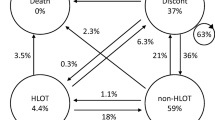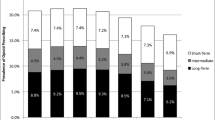ABSTRACT
OBJECTIVE
To report chronic opioid therapy discontinuation rates after five years and identify factors associated with discontinuation.
METHODS
Medical and pharmacy claims records from January 2000 through December 2005 from a national private health network (HealthCore), and Arkansas (AR) Medicaid were used to identify ambulatory adult enrollees who had 90 days of opioids supplied. Recipients were followed until they discontinued opioid prescription fills or disenrolled. Kaplan Meier survival models and Cox proportional hazards models were estimated to identify factors associated with time until opioid discontinuation.
RESULTS
There were 23,419 and 6,848 chronic opioid recipients followed for a mean of 1.9 and 2.3 years in the HealthCore and AR Medicaid samples. Over a maximum follow up of 4.8 years, 67.0% of HealthCore and 64.9% AR Medicaid recipients remained on opioids. Recipients on high daily opioid dose (greater than 120 milligrams morphine equivalent (MED)) were less likely to discontinue than recipients taking lower doses: HealthCore hazard ratio (HR) = 0.66 (95%CI: 0.57–0.76), AR Medicaid HR = 0.66 (95%CI: 0.50–0.82). Recipients with possible opioid misuse were also less likely to discontinue: HealthCore HR = 0.83 (95%CI: 0.78–0.89), AR Medicaid HR = 0.78 (95%CI: 0.67–0.90).
CONCLUSIONS
Over half of persons receiving 90 days of continuous opioid therapy remain on opioids years later. Factors most strongly associated with continuation were intermittent prior opioid exposure, daily opioid dose ≥ 120 mg MED, and possible opioid misuse. Since high dose and opioid misuse have been shown to increase the risk of adverse outcomes special caution is warranted when prescribing more than 90 days of opioid therapy in these patients.



Similar content being viewed by others
References
Noble M, Tregear SJ, Treadwell JR, Schoelles K. Long-term opioid therapy for chronic noncancer pain: a systematic review and meta-analysis of efficacy and safety. J Pain Symptom Manage. 2008;35(2):214–228.
Trescot AM, Boswell MV, Atluri SL, et al. Opioid guidelines in the management of chronic non-cancer pain. Pain Physician. 2006;9(1):1–39.
Sandner-Kiesling A, Leyendecker P, Hopp M, Tarau L, Lejcko J, Meissner W, Sevcik P, Hakl M, Hrib R, Uhl R, Dürr H, Reimer K. Long-term efficacy and safety of combined prolonged-release oxycodone and naloxone in the management of non-cancer chronic pain. Int J Clin Pract. 2010;64(6):763–74.
Papaleontiou M, Henderson CR Jr, Turner BJ, Moore AA, Olkhovskaya Y, Amanfo L, Reid MC. Outcomes associated with opioid use in the treatment of chronic noncancer pain in older adults: a systematic review and meta-analysis. J Am Geriatr Soc. 2010;58(7):1353–69.
Chou R, Fanciullo GJ, Fine PG, et al. American Pain Society-American Academy of Pain Medicine Opioids Guidelines Panel. Clinical guidelines for the use of chronic opioid therapy in chronic noncancer pain. J Pain. 2009;10(2):113–130.
Caudill-Slosberg MA, Schwartz LM, Woloshin S. Office visits and analgesic prescriptions for musculoskeletal pain in US: 1980 vs. 2000. Pain. 2004;109(3):514–519.
Gilson AM, Ryan KM, Joranson DE, Dahl JL. A reassessment of trends in the medical use and abuse of opioid analgesics and implications for diversion control: 1997–2002. J Pain Symptom Manage. 2004;28(2):176–188.
Sullivan MD, Edlund MJ, Fan MY, DeVries A, Braden JB, Martin BC. Trends in use of opioids for non-cancer pain conditions 2000–2005 in Commercial and Medicaid insurance plans: the TROUP study. Pain. 2008;138:440–449.
Compton WM, Volkow ND. Major increases in opioid analgesic abuse in the United States: concerns and strategies. Drug Alcohol Depend. 2006;81(2):103–107.
Paulozzi LJ, Ryan GW. Opioid analgesics and rates of fatal drug poisoning in the United States. Am J Prev Med. 2006;31(6):506–511.
Dunn KM, Saunders KW, Rutter CM, et al. Opioid prescriptions for chronic pain and overdose: a cohort study. Ann Intern Med. 2010;152(2):85–92.
Saunders KW, Dunn KM, Merrill JO, et al. Relationship of opioid use and dosage levels to fractures in older chronic pain patients. J Gen Intern Med. 2010;25(4):310–5.
Edlund MJ, Martin BC, Fan MY, DeVries A, Braden JB, Sullivan MD. Risks for opioid abuse and dependence among recipients of chronic opioid therapy: Results from the TROUP Study. Drug Alcohol Depend. 2010;112(1–2):90–8.
Charlson ME, Pompei P, Ales KL, MacKenzie CR. A new method of classifying prognostic comorbidity in longitudinal studies: development and validation. J Chronic Dis. 1987;40(5):373–383.
Clinical Classification Software (CCS) for ICD-9 CM [computer program]. Version. Rockville, MD: Agency for Healthcare Research and Quality.
Sullivan MD, Edlund MJ, Fan MY, Devries A, Brennan Braden J, Martin BC. Risks for possible and probable opioid misuse among recipients of chronic opioid therapy in commercial and Medicaid insurance plans: The TROUP Study. Pain. 2010;150(2):332–9.
SAS [computer program]. Version 9.1. Cary, NC: SAS Institute, Inc.
Franklin GM, Rahman EA, Turner JA, Daniell WE, Fulton-Kehoe D. Opioid use for chronic low back pain: A prospective, population-based study among injured workers in Washington state, 2002–2005. Clin J Pain. 2009;25(9):743–751.
Ballantyne JC, Shin NS. Efficacy of opioids for chronic pain: a review of the evidence. Clin J Pain. 2008;24(6):469–78.
Gomes T, Mamdani MM, Dhalla IA, Paterson JM, Juurlink DN. Opioid dose and drug-related mortality in patients with nonmalignant pain. Arch Intern Med. 2011;171(7):686–91.
White AG, Birnbaum HG, Shiller M, Tang J, Katz NP. Analytic models to identify patients at risk for prescription opioid abuse. Am J Manag Care. 2009;15(12):897–906.
Reid MC, Engles-Horton LL, Weber MB, Kerns RD, Rogers EL, O'Connor PG. Use of opioid medications for chronic noncancer pain syndromes in primary care. J Gen Intern Med. 2002;17(3):173–179.
Becker WC, Sullivan LE, Tetrault JM, Desai RA, Fiellin DA. Non-medical use, abuse and dependence on prescription opioids among U.S. adults: psychiatric, medical and substance use correlates. Drug Alcohol Depend. 2008;94(1–3):38–47.
Breckenridge J, Clark JD. Patient characteristics associated with opioid versus nonsteroidal anti-inflammatory drug management of chronic low back pain. J Pain. 2003;4(6):344–350.
Edlund MJ, Martin BC, Devries A, Fan MY, Braden JB, Sullivan MD. Trends in use of opioids for chronic noncancer pain among individuals with mental health and substance use disorders: the TROUP study. Clin J Pain. 2010;26(1):1–8.
Sullivan MD, Edlund MJ, Zhang L, Unutzer J, Wells KB. Association between mental health disorders, problem drug use, and regular prescription opioid use. Arch Intern Med. 2006;166(19):2087–2093.
Wolf BC, Lavezzi WA, Sullivan LM, Flannagan LM. One hundred seventy two deaths involving the use of oxycodone in Palm Beach County. J Forensic Sci. 2005;50(1):192–5.
PRESCRIPTION DRUG ABUSE CRISIS. http://www.whitehousedrugpolicy.gov/publications/pdf/rx_abuse_plan.pdf (last accessed April 27, 2011).
Acknowledgements
This research was supported by a grant from the National Institute on Drug Abuse DA022560 to Dr. Mark D. Sullivan. Dr. Jennifer Brennan Braden was supported by a Ruth L. Kirschstein National Research Service Award (NRSA) Institutional Research Training Grant [T32 MH20021 (Katon)]. Gary Moore provided invaluable programming support in preparing the analytic files from AR Medicaid. The Arkansas Department of Human Services, Division of Medical Services provided no-cost access to the AR Medicaid claims files. Dr. Andrea DeVries is an employee of HealthCore. Dr. Ming-Yu Fan is currently an employee of eBay. Dr. Bradley C. Martin is a consultant to Daiichi Sankyo for work unrelated to the current study. Dr. Mark D. Sullivan had full access to all of the data in the study and takes responsibility for the integrity of the data andthe accuracy of the data analysis.
Conflict of Interest
None disclosed.
Author information
Authors and Affiliations
Corresponding author
Rights and permissions
About this article
Cite this article
Martin, B.C., Fan, MY., Edlund, M.J. et al. Long-Term Chronic Opioid Therapy Discontinuation Rates from the TROUP Study. J GEN INTERN MED 26, 1450–1457 (2011). https://doi.org/10.1007/s11606-011-1771-0
Received:
Revised:
Accepted:
Published:
Issue Date:
DOI: https://doi.org/10.1007/s11606-011-1771-0




